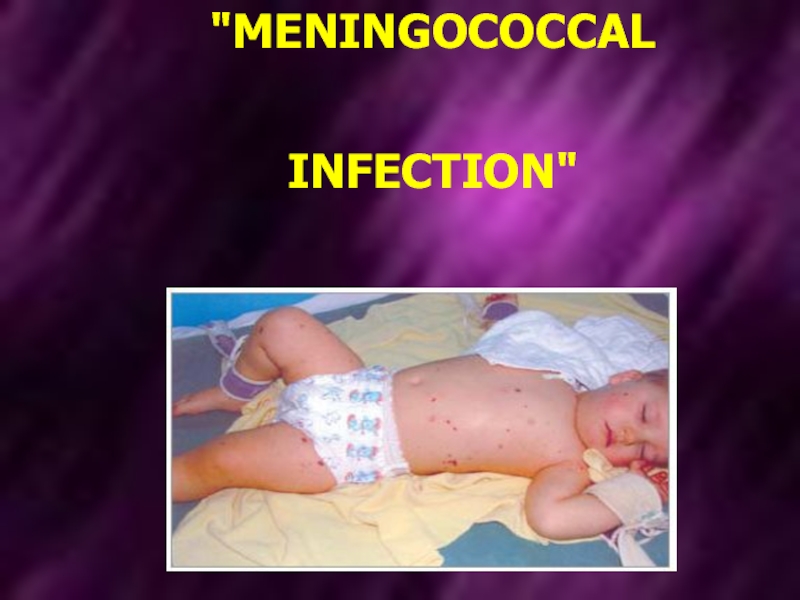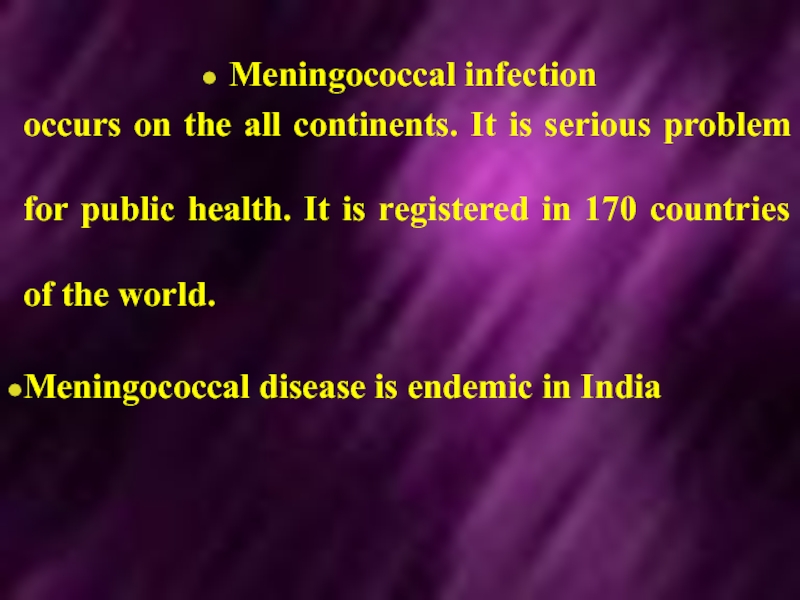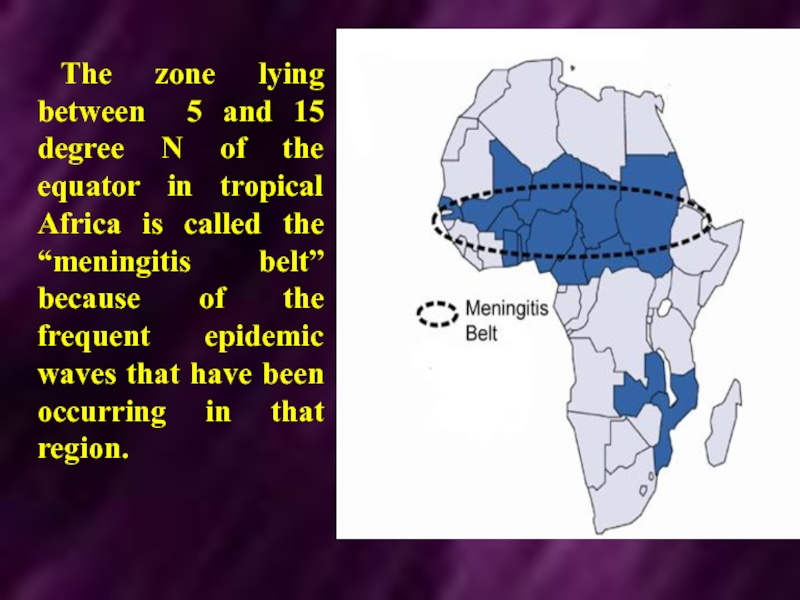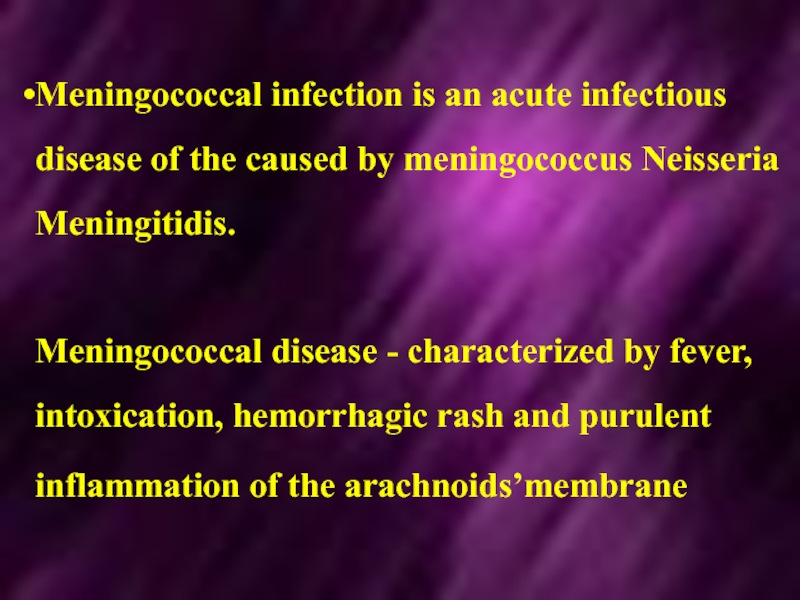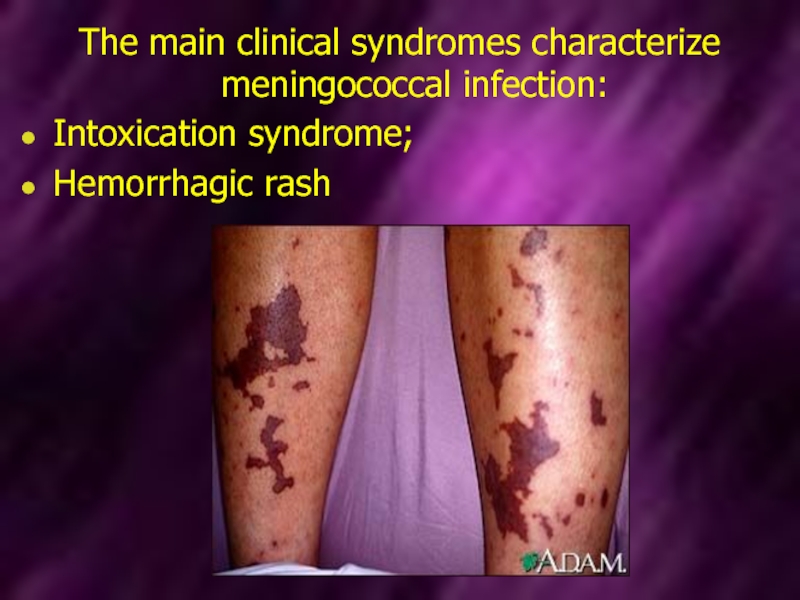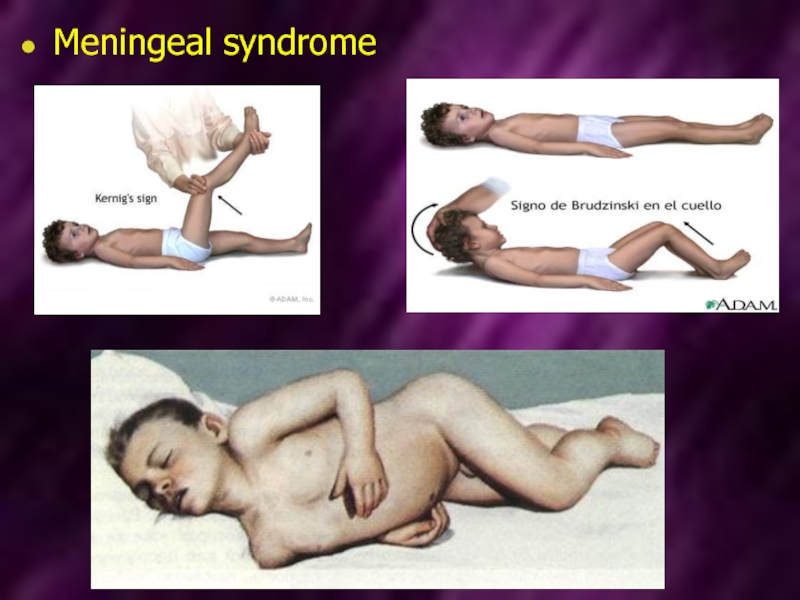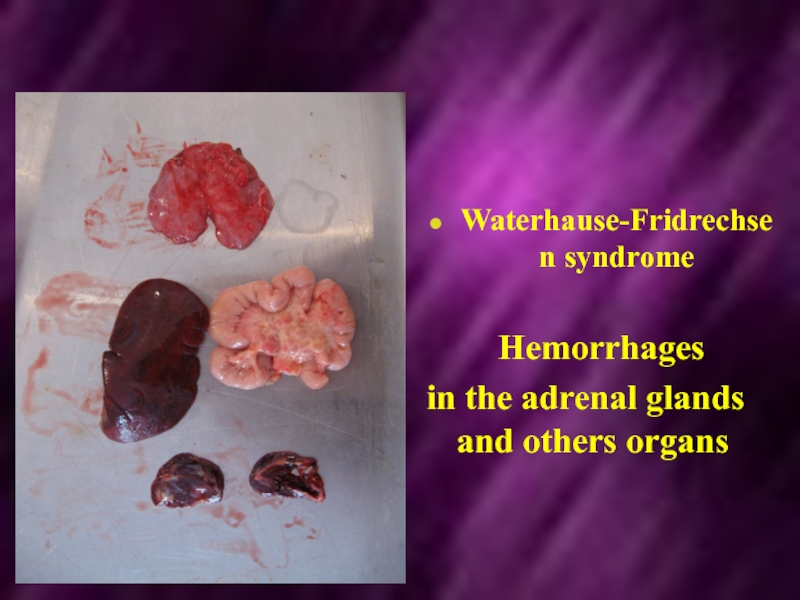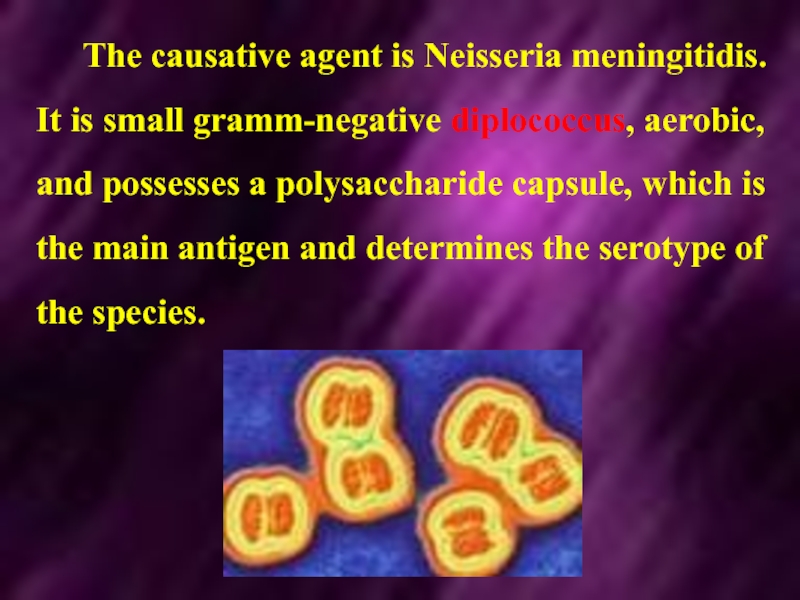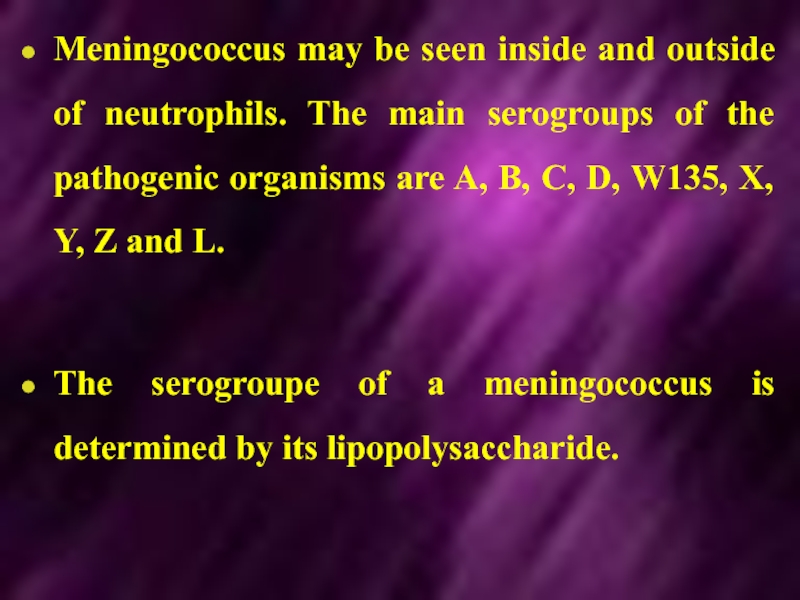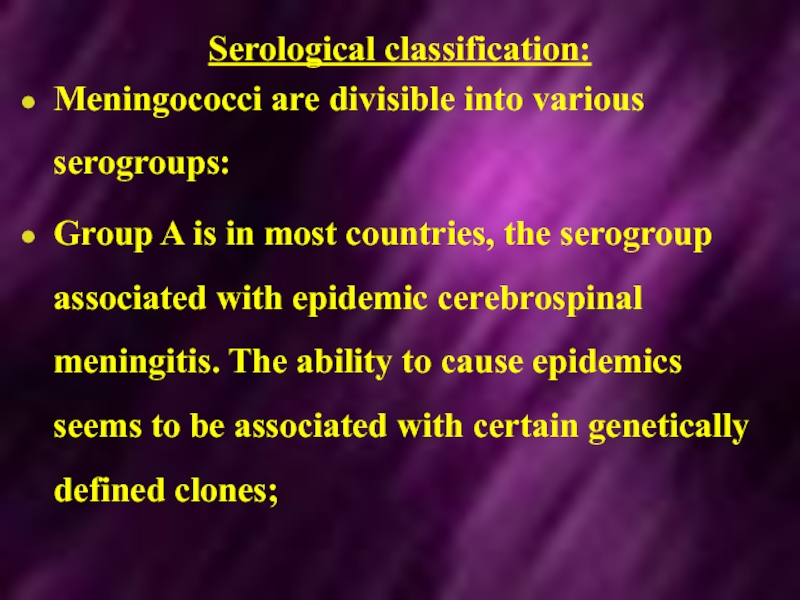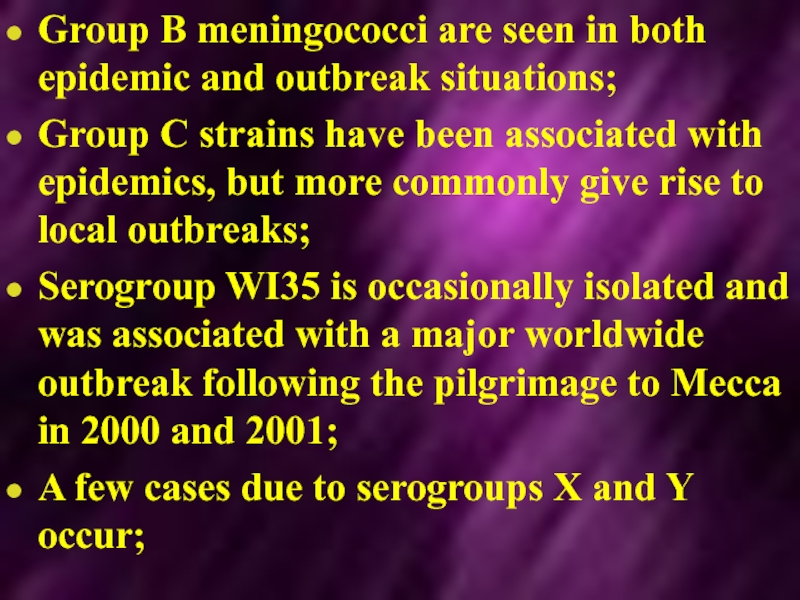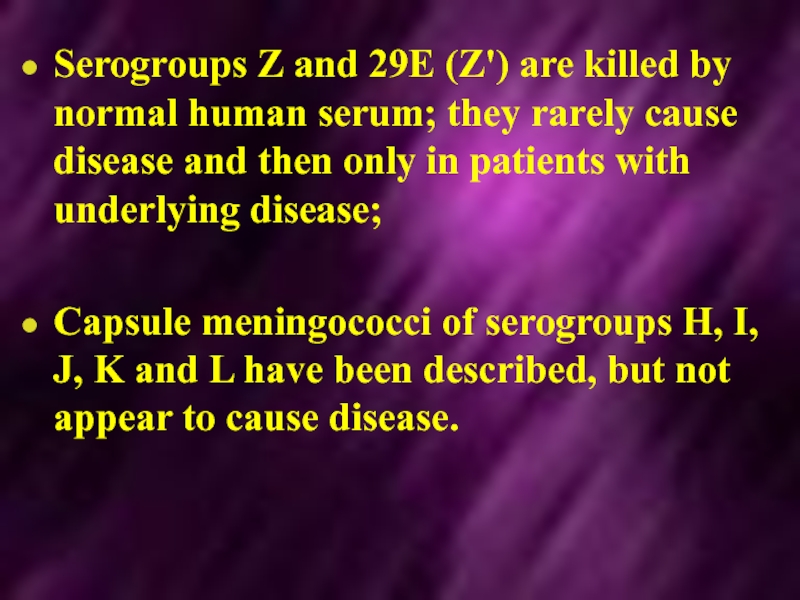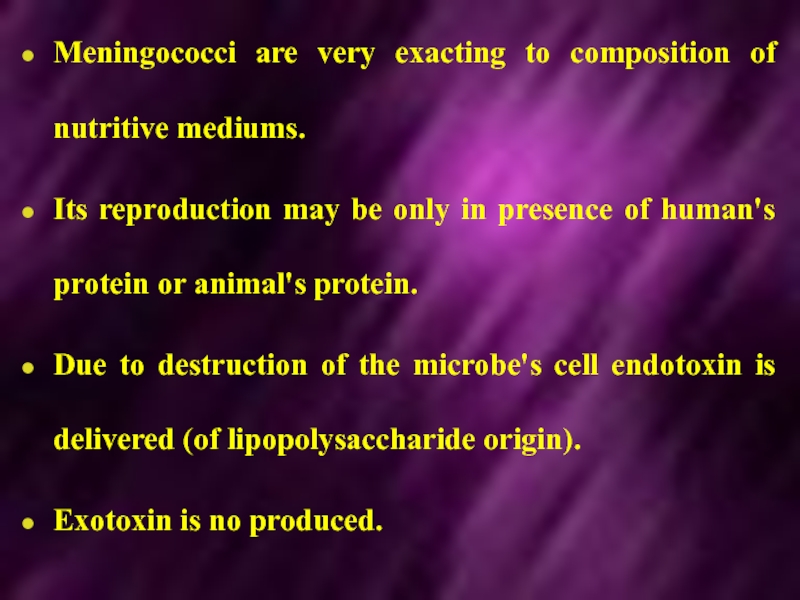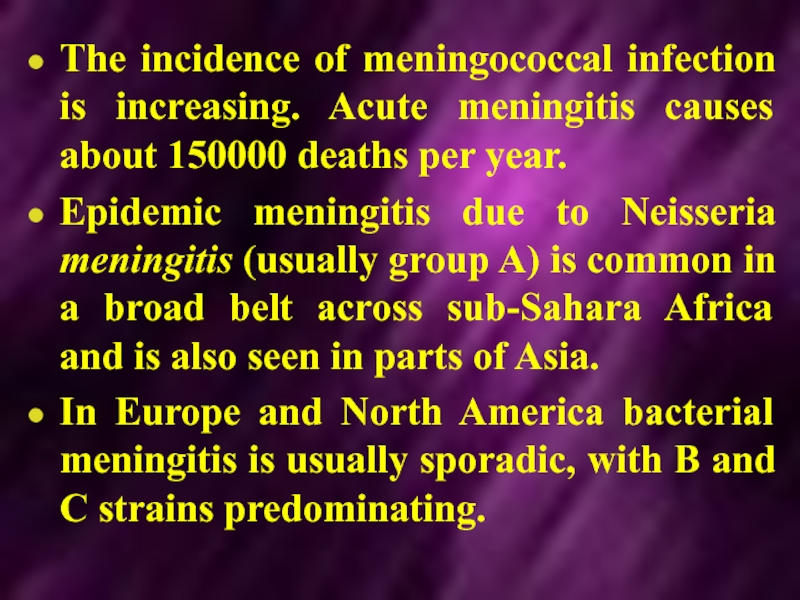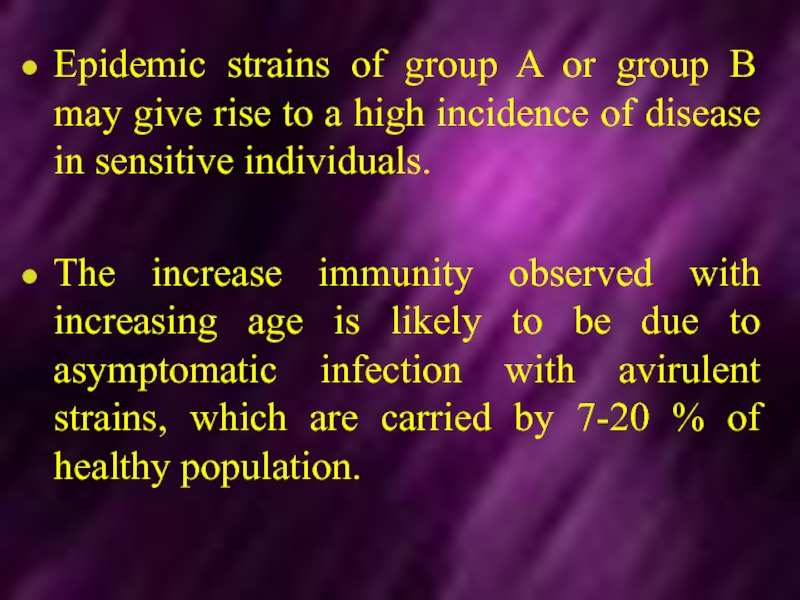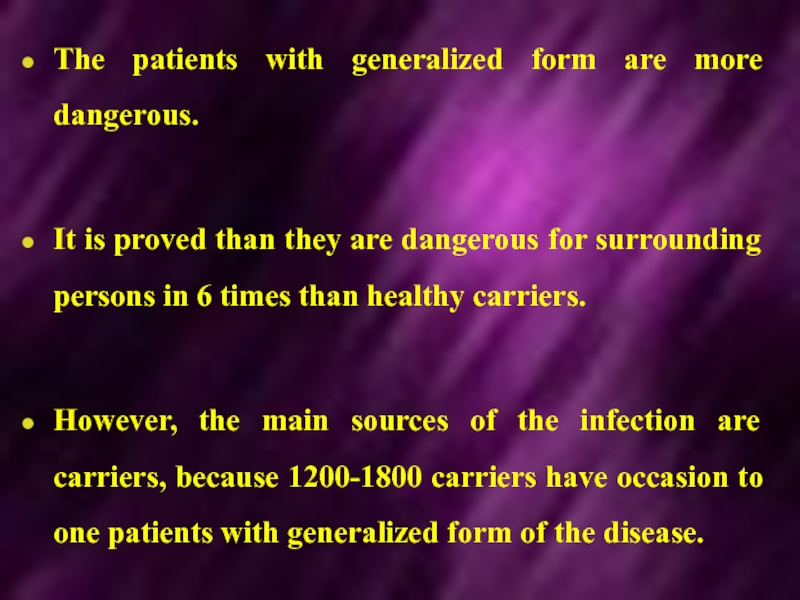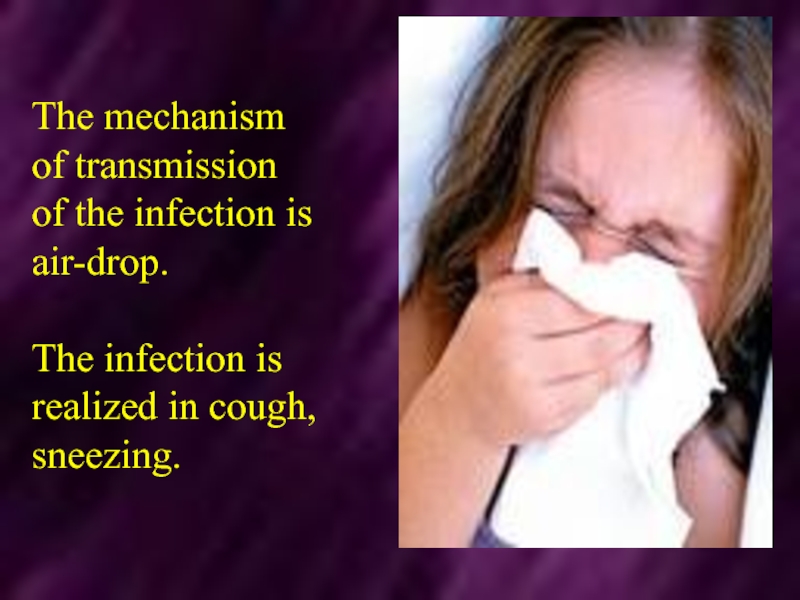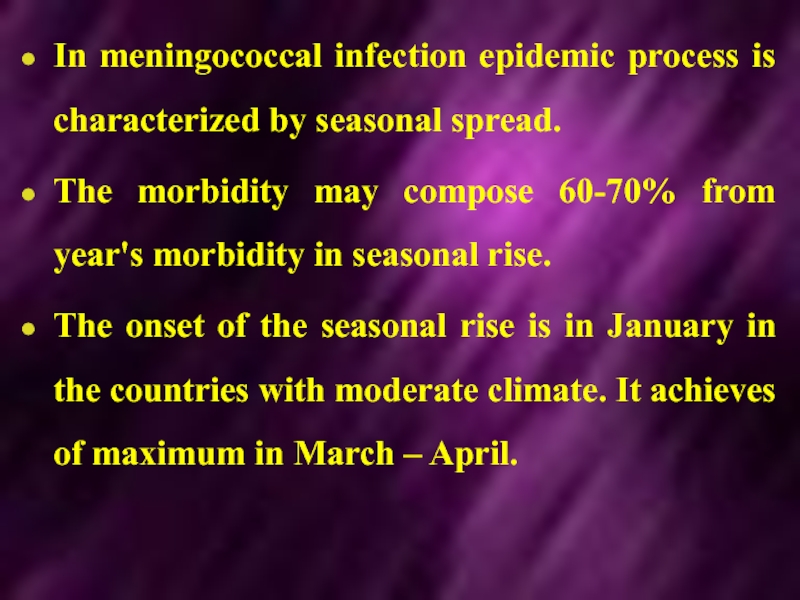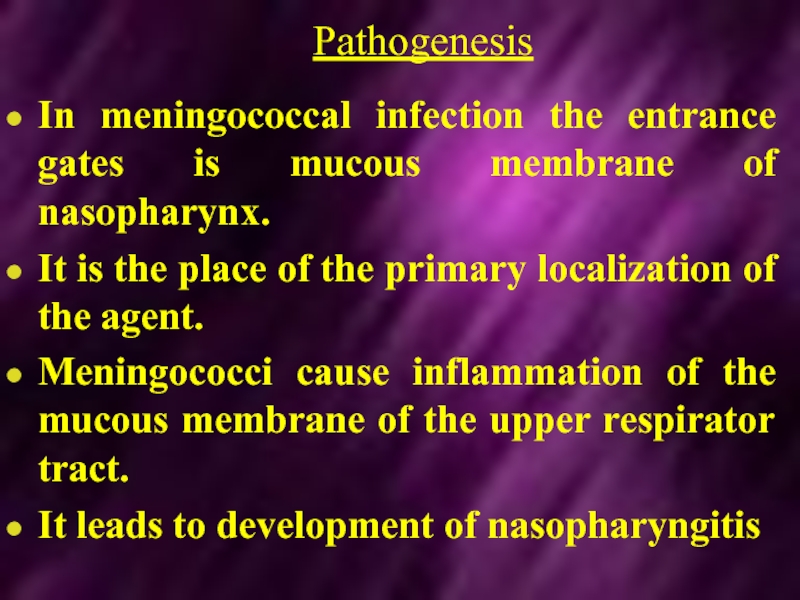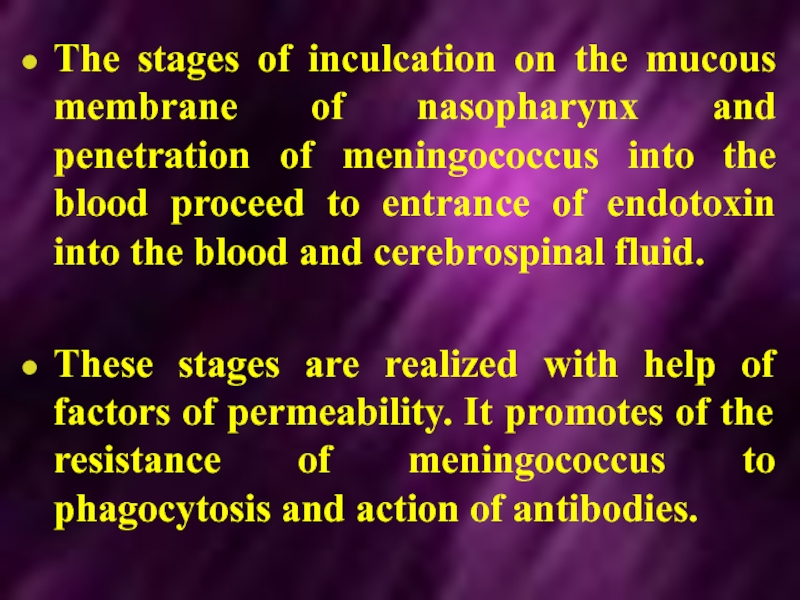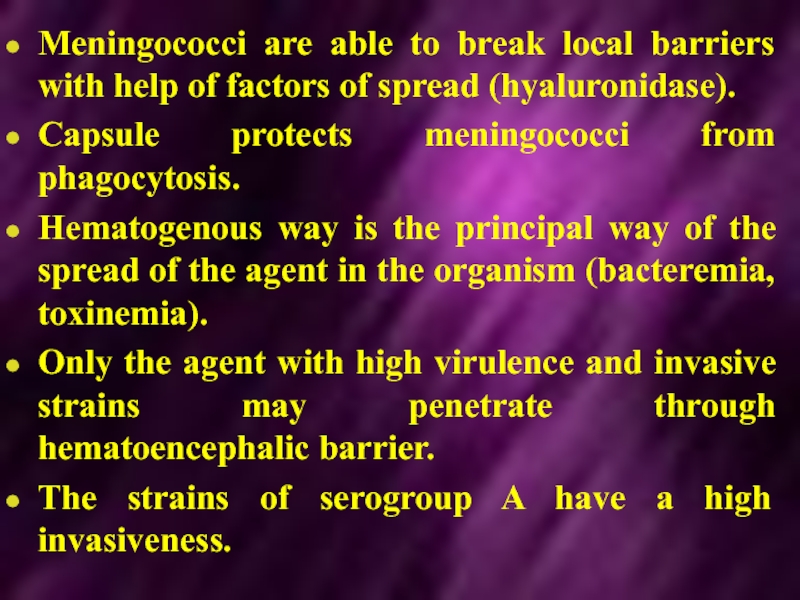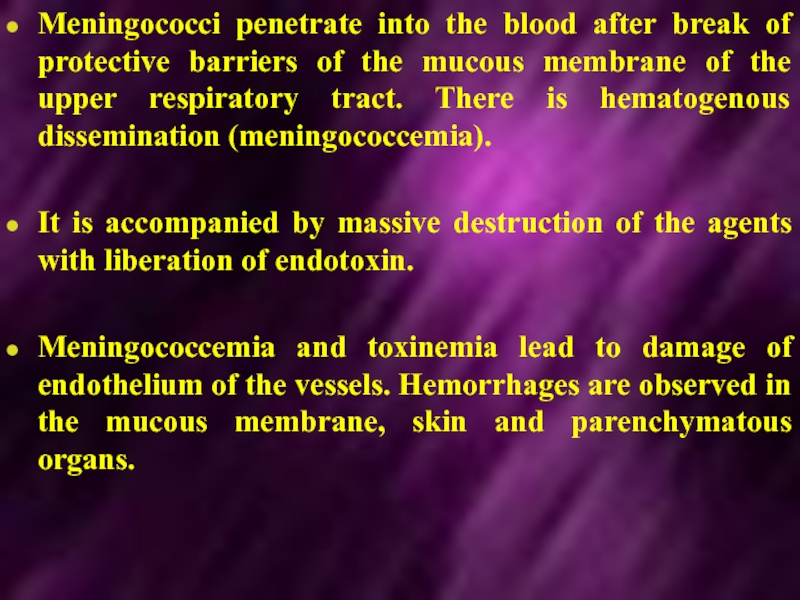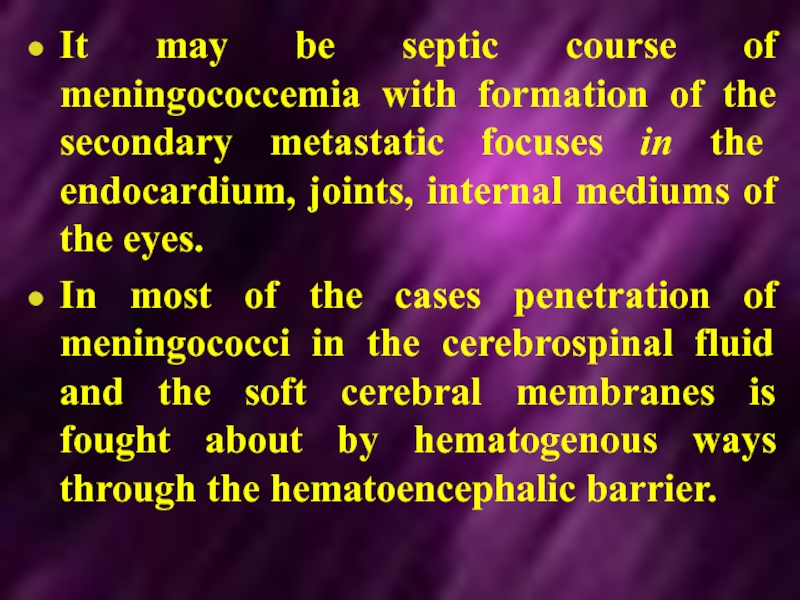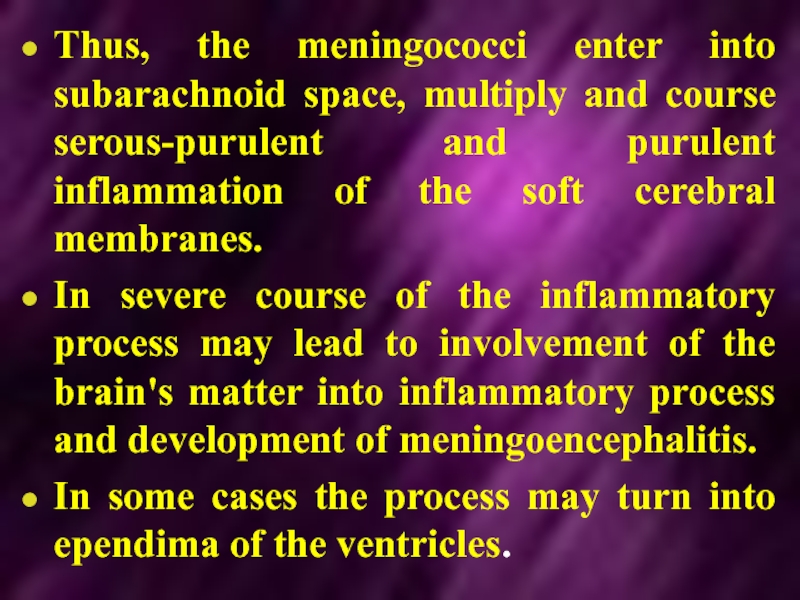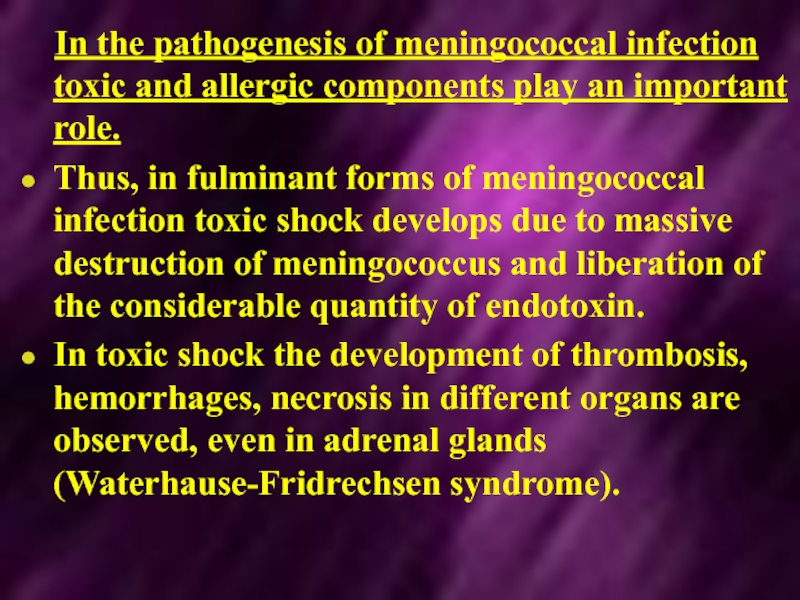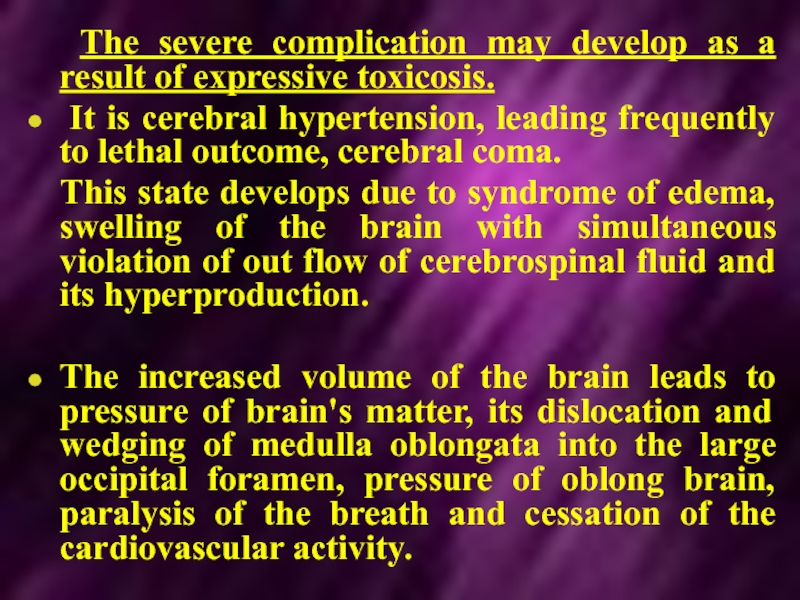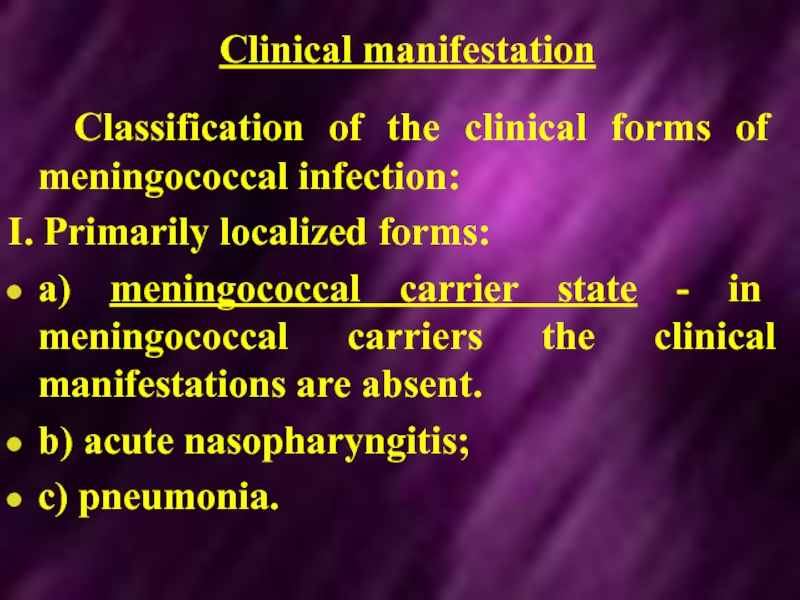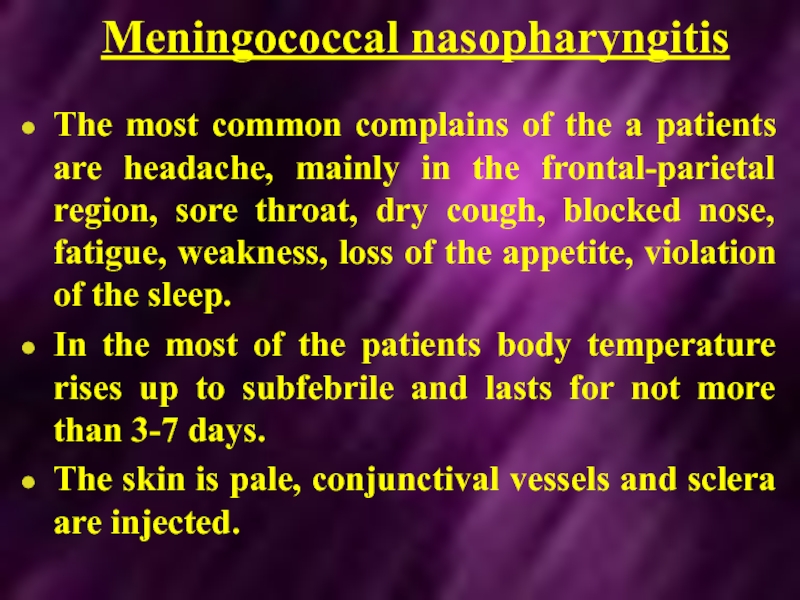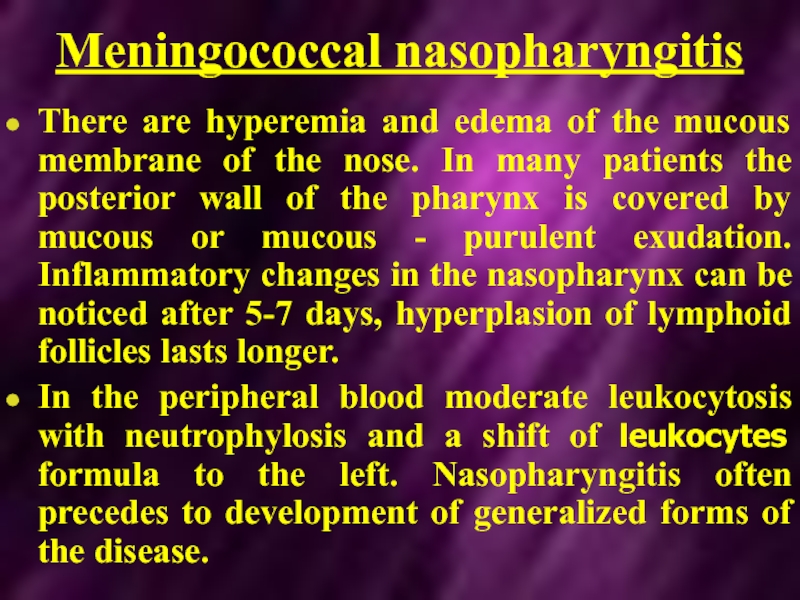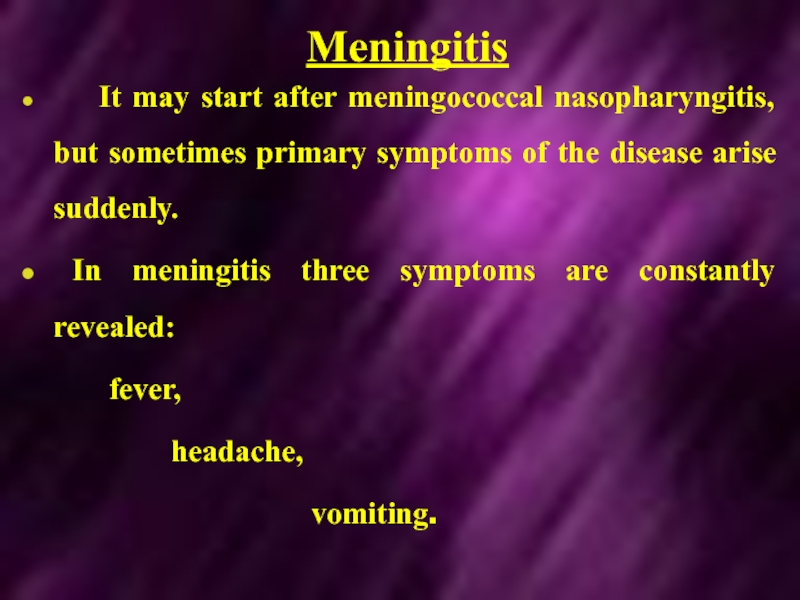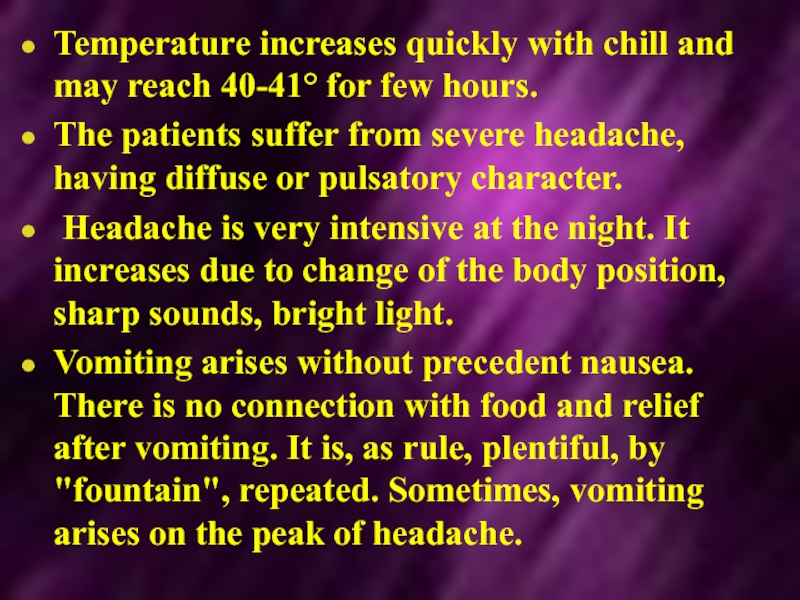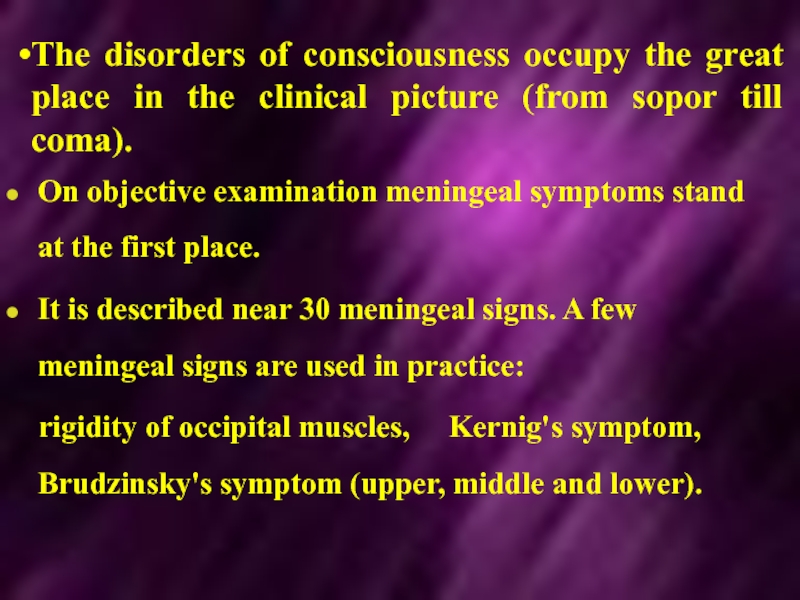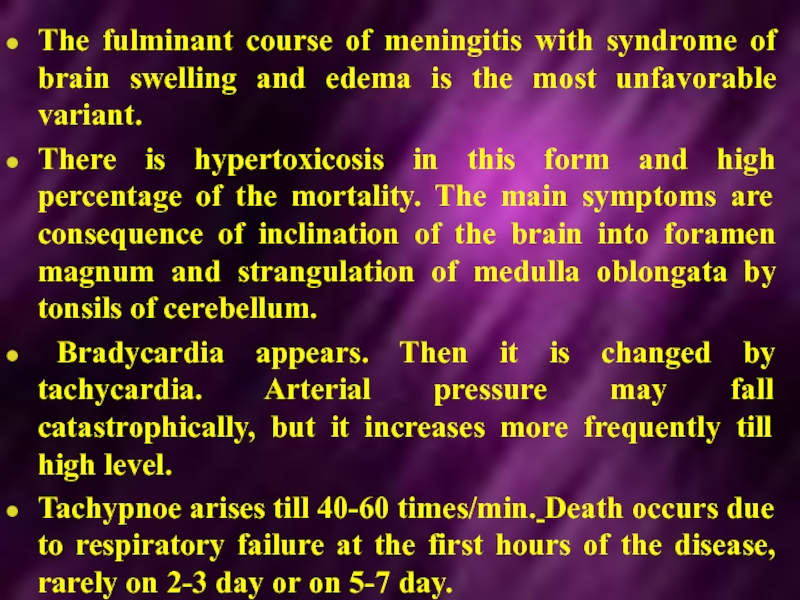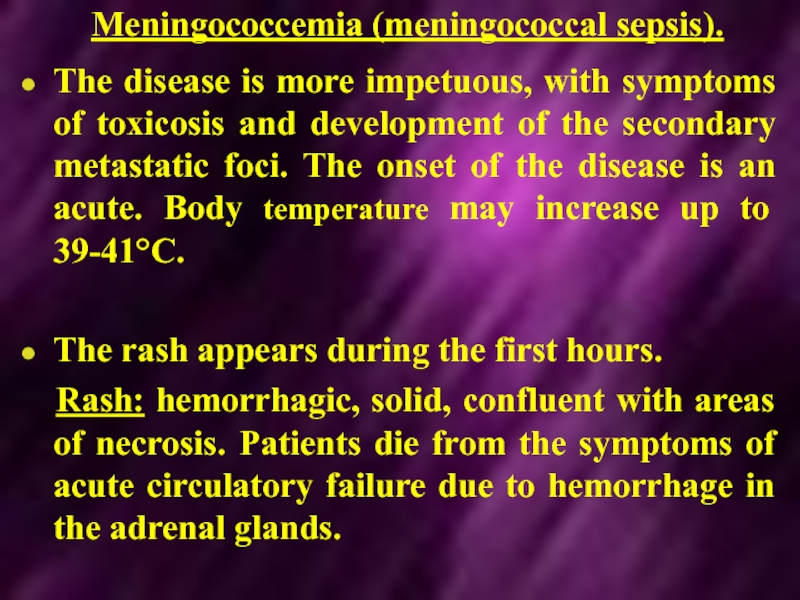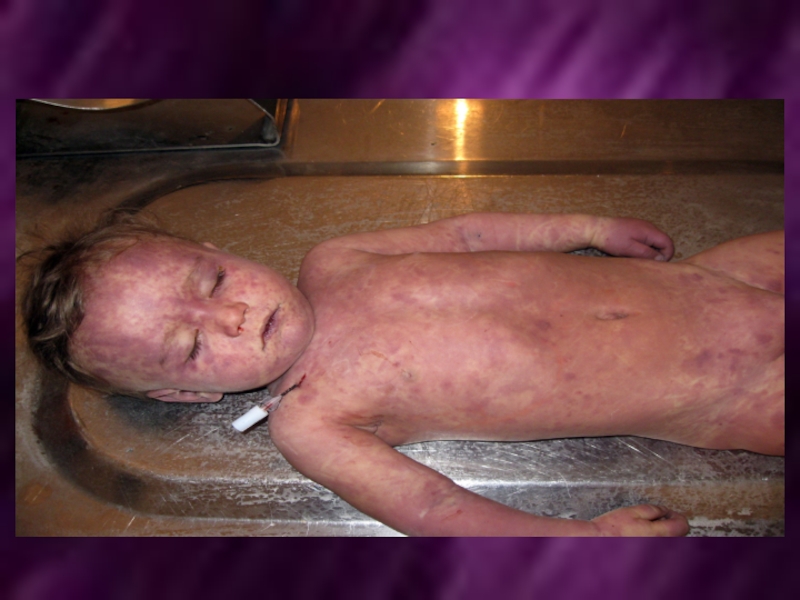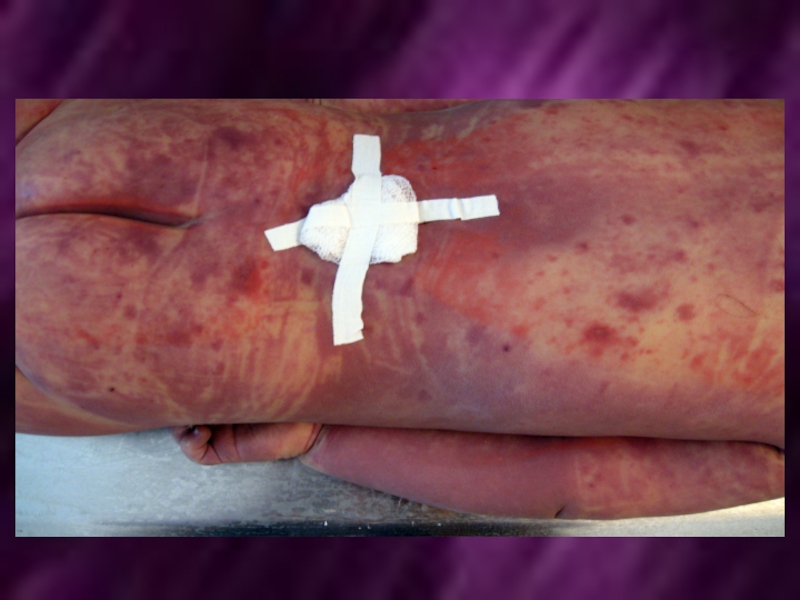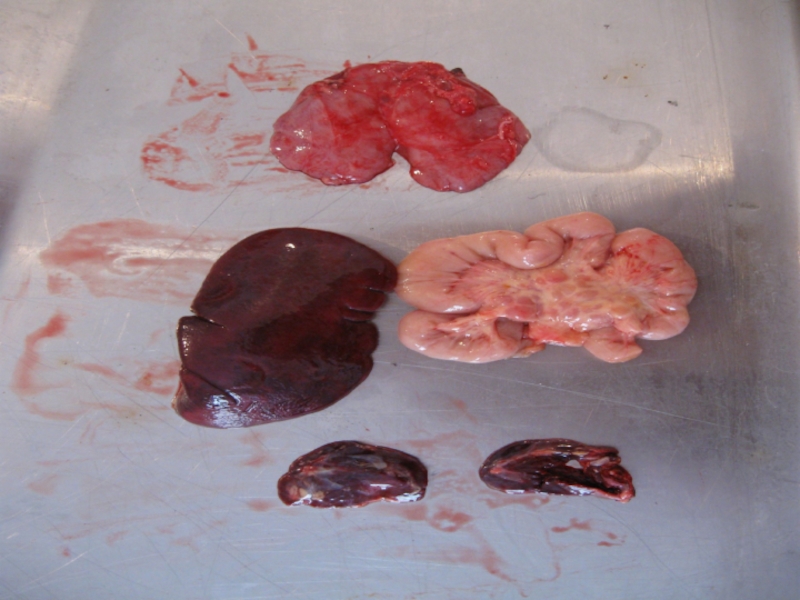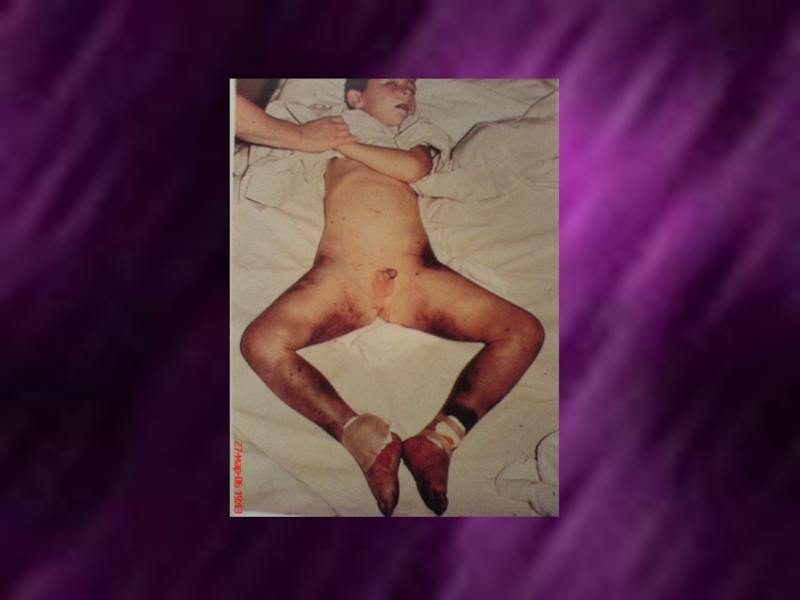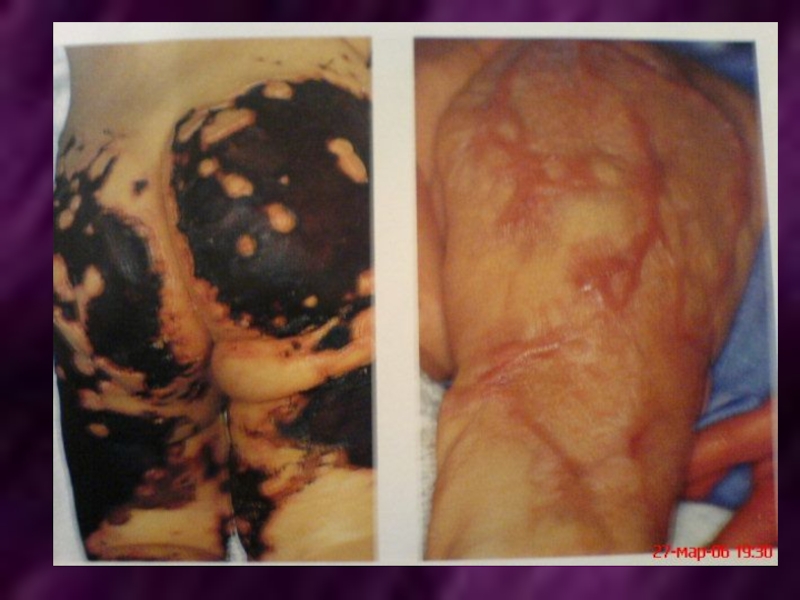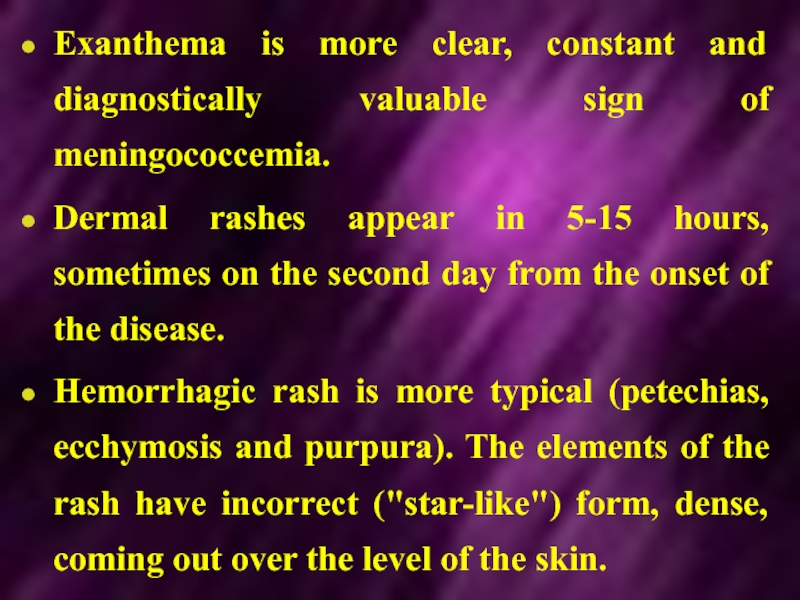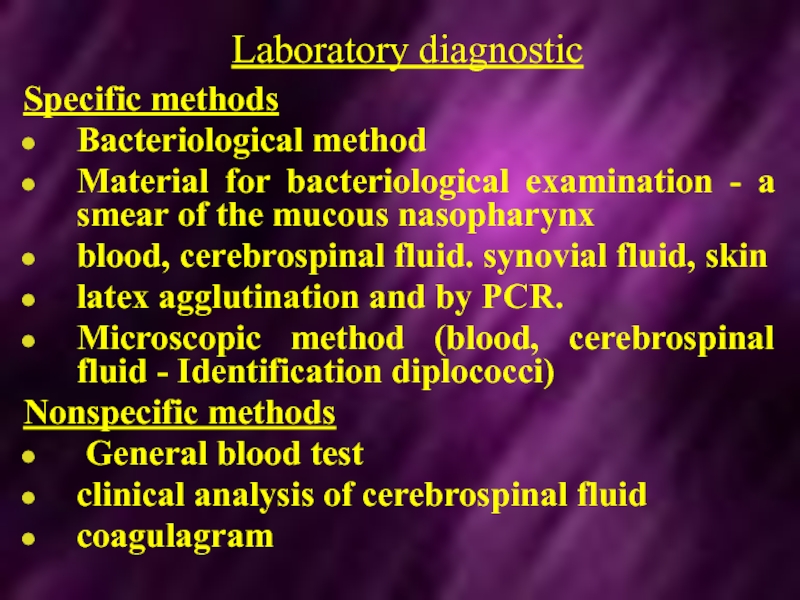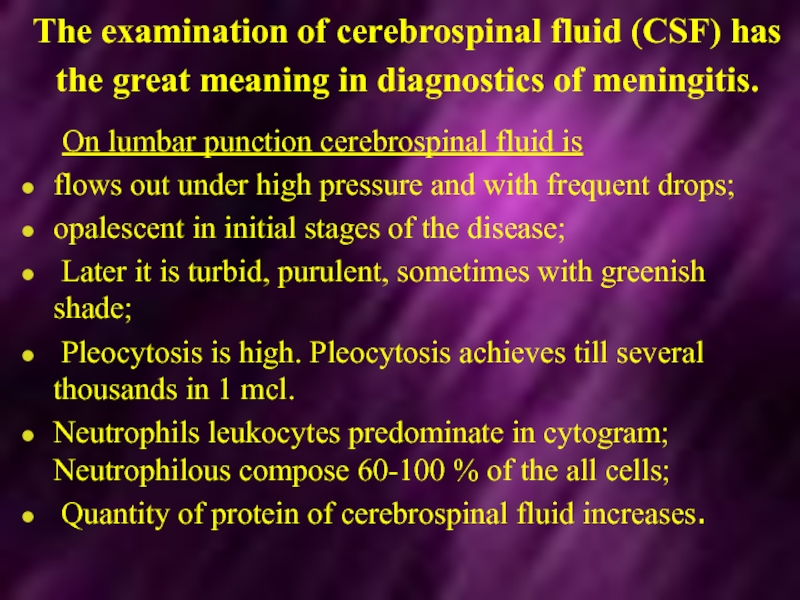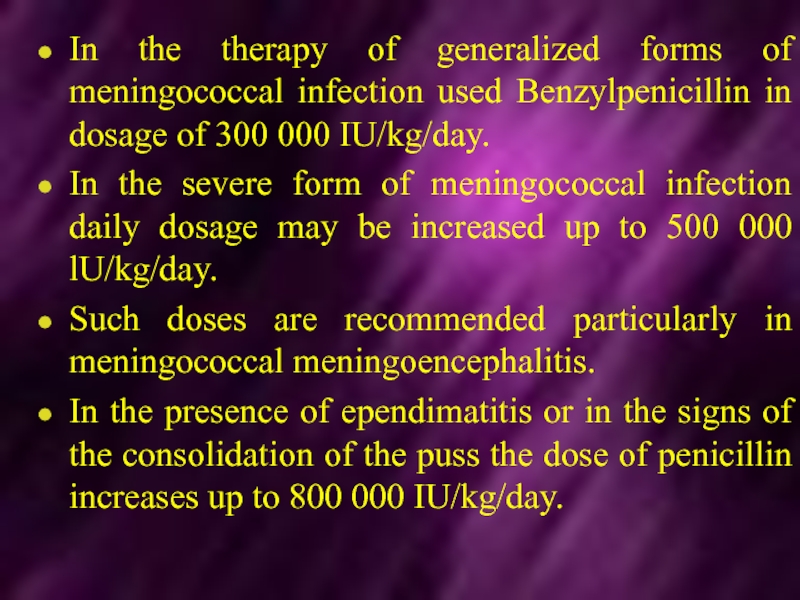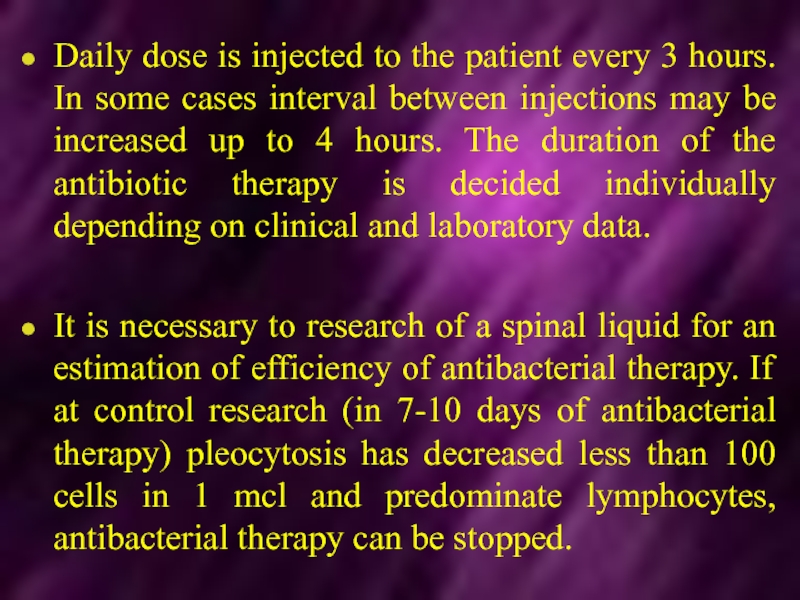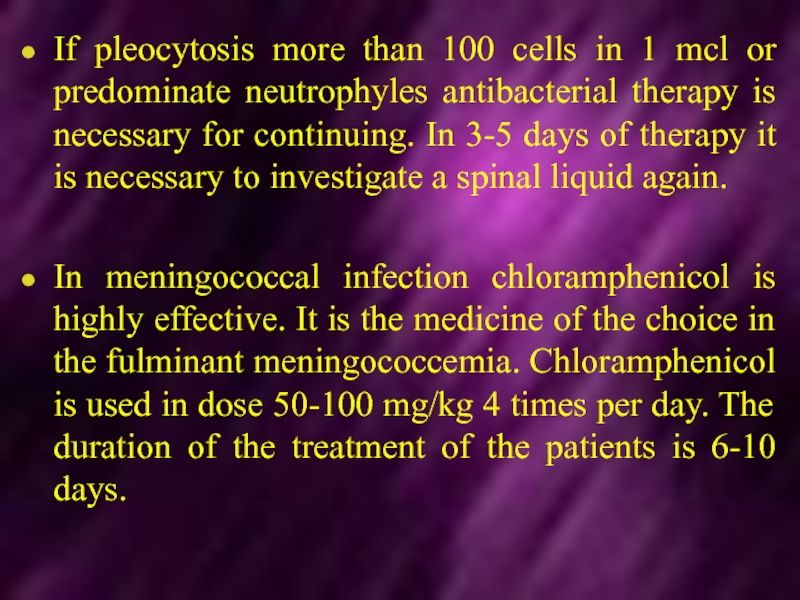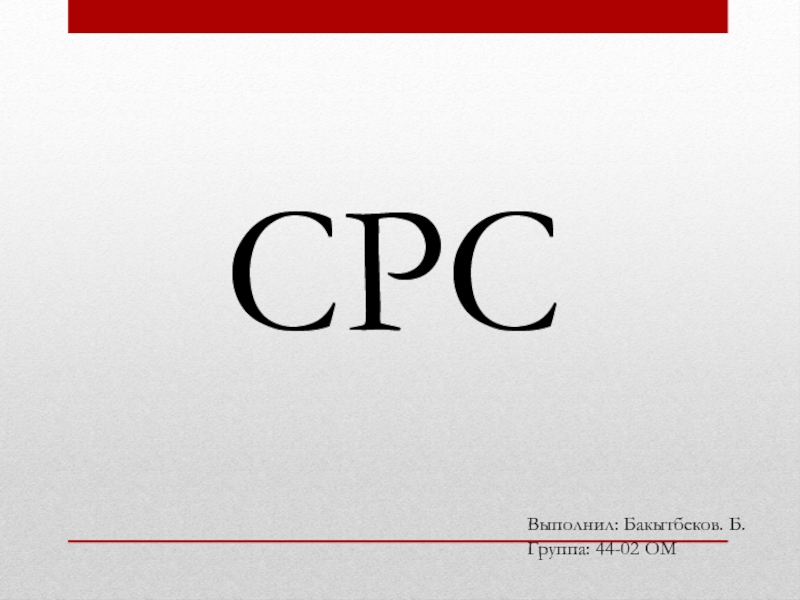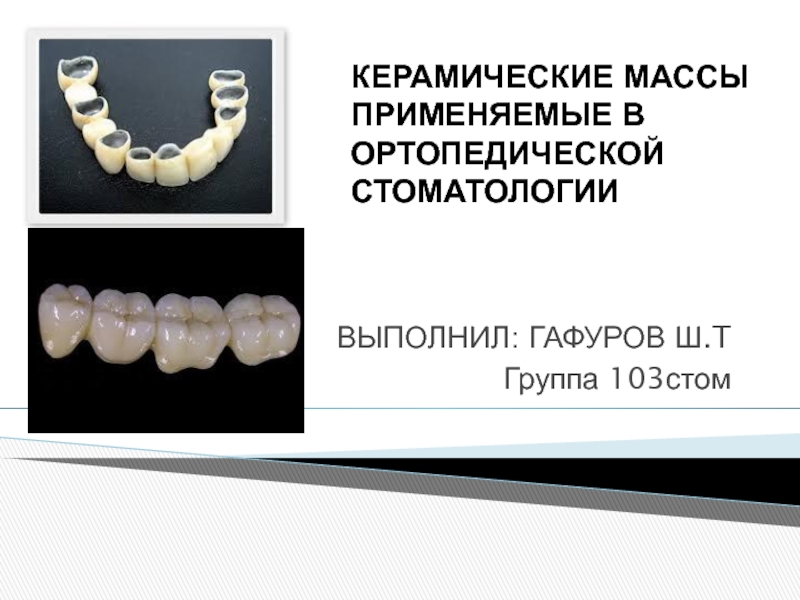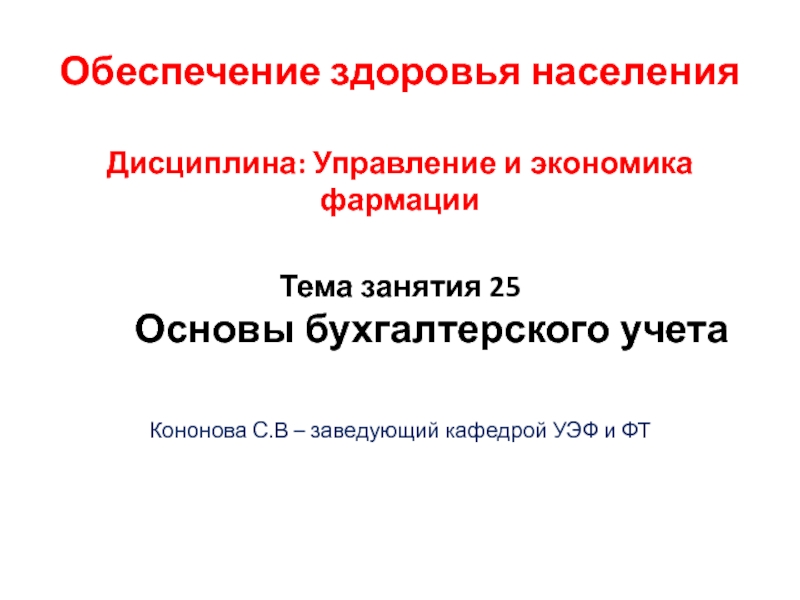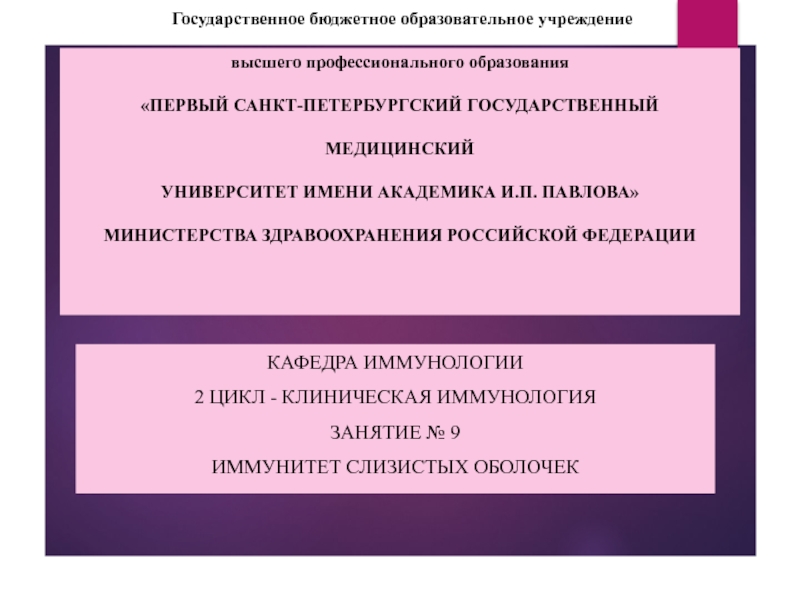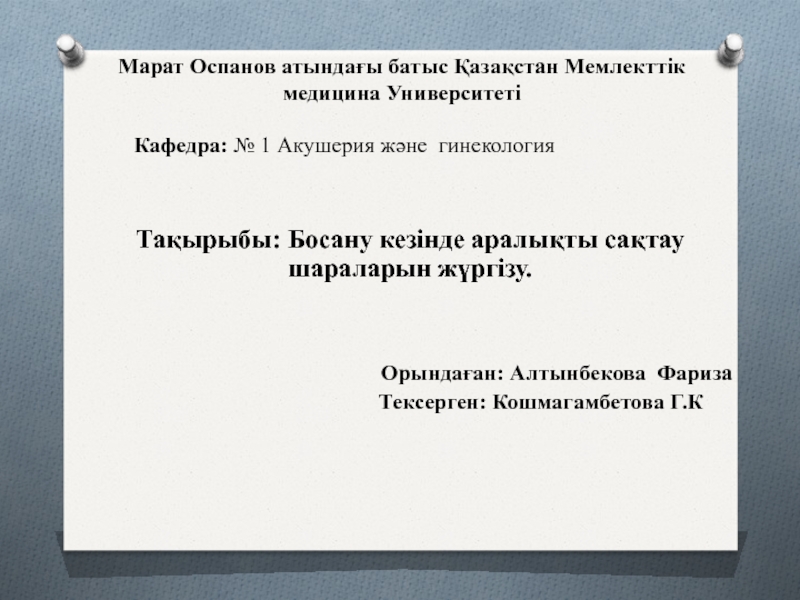- Главная
- Разное
- Дизайн
- Бизнес и предпринимательство
- Аналитика
- Образование
- Развлечения
- Красота и здоровье
- Финансы
- Государство
- Путешествия
- Спорт
- Недвижимость
- Армия
- Графика
- Культурология
- Еда и кулинария
- Лингвистика
- Английский язык
- Астрономия
- Алгебра
- Биология
- География
- Детские презентации
- Информатика
- История
- Литература
- Маркетинг
- Математика
- Медицина
- Менеджмент
- Музыка
- МХК
- Немецкий язык
- ОБЖ
- Обществознание
- Окружающий мир
- Педагогика
- Русский язык
- Технология
- Физика
- Философия
- Химия
- Шаблоны, картинки для презентаций
- Экология
- Экономика
- Юриспруденция
Meningococcal infection презентация
Содержание
- 1. Meningococcal infection
- 2. Meningococcal infection occurs on the
- 3. The zone lying between 5 and 15
- 4. Meningococcal infection is an acute infectious disease
- 5. The main clinical syndromes characterize meningococcal infection:
- 6. Meningeal syndrome
- 7. Waterhause-Fridrechsen syndrome
- 8. The disease is characterized by damage of
- 9. The causative agent is Neisseria meningitidis. It
- 10. Meningococcus may be seen inside and outside
- 11. Serological classification: Meningococci are divisible into various
- 12. Group B meningococci are seen in both
- 13. Serogroups Z and 29E (Z') are killed
- 14. Meningococci are very exacting to composition of
- 15. The agent of meningococcal infection is characterized
- 16. Epidemiology Meningococcal infections occur worldwide and
- 17. The incidence of meningococcal infection is increasing.
- 18. Epidemic strains of group A or group
- 19. The patients with generalized form are more
- 20. The mechanism of transmission of the infection
- 21. In this the narrow contact and
- 22. In meningococcal infection epidemic process is characterized
- 23. Pathogenesis In meningococcal infection the entrance
- 24. The stages of inculcation on the mucous
- 25. Meningococci are able to break local barriers
- 26. Meningococci penetrate into the blood after break
- 27. It may be septic course of meningococcemia
- 28. Thus, the meningococci enter into subarachnoid space,
- 29. In the pathogenesis of meningococcal
- 30. The severe complication may develop
- 31. Clinical manifestation Classification of the
- 32. II. Generalized forms: a) meningococcemia: typical,
- 33. Meningococcal nasopharyngitis The most common complains of
- 34. Meningococcal nasopharyngitis There are hyperemia and edema
- 35. Meningitis It may start
- 36. Temperature increases quickly with chill and may
- 37. The disorders of consciousness occupy the great
- 38. The fulminant course of meningitis with syndrome
- 39. Meningococcemia (meningococcal sepsis). The disease is more
- 45. Exanthema is more clear, constant and diagnostically
- 46. The deep and extensive hemorrhages may be
- 47. Laboratory diagnostic Specific methods Bacteriological method Material
- 48. The examination of cerebrospinal fluid (CSF) has
- 49. Treatment The therapeutic tactics depends
- 50. In the therapy of generalized forms of
- 51. Daily dose is injected to the patient
- 52. If pleocytosis more than 100 cells in
- 53. Prophylaxis Prophylactic measures, directing on the sources
Слайд 2 Meningococcal infection
occurs on the all continents. It is serious
Meningococcal disease is endemic in India
Слайд 3The zone lying between 5 and 15 degree N of the
Слайд 4Meningococcal infection is an acute infectious disease of the caused by
Слайд 5The main clinical syndromes characterize meningococcal infection:
Intoxication syndrome;
Hemorrhagic rash
Слайд 8The disease is characterized by damage of the -- mucous membrane
Generalization of the process in the form of specific septicemia (meningococcemia) and inflammation of the soft cerebral membranes (meningitis).
Слайд 9The causative agent is Neisseria meningitidis. It is small gramm-negative diplococcus,
Слайд 10Meningococcus may be seen inside and outside of neutrophils. The main
The serogroupe of a meningococcus is determined by its lipopolysaccharide.
Слайд 11Serological classification:
Meningococci are divisible into various serogroups:
Group A is in most
Слайд 12Group B meningococci are seen in both epidemic and outbreak situations;
Group
Serogroup WI35 is occasionally isolated and was associated with a major worldwide outbreak following the pilgrimage to Mecca in 2000 and 2001;
A few cases due to serogroups X and Y occur;
Слайд 13Serogroups Z and 29E (Z') are killed by normal human serum;
Capsule meningococci of serogroups H, I, J, K and L have been described, but not appear to cause disease.
Слайд 14Meningococci are very exacting to composition of nutritive mediums.
Its reproduction
Due to destruction of the microbe's cell endotoxin is delivered (of lipopolysaccharide origin).
Exotoxin is no produced.
Слайд 15The agent of meningococcal infection is characterized by low resistance in
Meningococci perish in the temperature 50°C for 5 minutes, in the temperature 100°C - for 30 seconds.
Meningococci have a little resistance to low temperature.
Слайд 16Epidemiology
Meningococcal infections occur worldwide and are notifiable in most countries.
About
The large part of carriers is reveled among adults.
The morbidity is higher in the towns.
Слайд 17The incidence of meningococcal infection is increasing. Acute meningitis causes about
Epidemic meningitis due to Neisseria meningitis (usually group A) is common in a broad belt across sub-Sahara Africa and is also seen in parts of Asia.
In Europe and North America bacterial meningitis is usually sporadic, with B and C strains predominating.
Слайд 18Epidemic strains of group A or group B may give rise
The increase immunity observed with increasing age is likely to be due to asymptomatic infection with avirulent strains, which are carried by 7-20 % of healthy population.
Слайд 19The patients with generalized form are more dangerous.
It is proved
However, the main sources of the infection are carriers, because 1200-1800 carriers have occasion to one patients with generalized form of the disease.
Слайд 20The mechanism of transmission of the infection is air-drop. The infection
Слайд 21
In this the narrow contact and sufficient exposition are necessary.
It
Слайд 22In meningococcal infection epidemic process is characterized by seasonal spread.
The
The onset of the seasonal rise is in January in the countries with moderate climate. It achieves of maximum in March – April.
Слайд 23Pathogenesis
In meningococcal infection the entrance gates is mucous membrane of nasopharynx.
It is the place of the primary localization of the agent.
Meningococci cause inflammation of the mucous membrane of the upper respirator tract.
It leads to development of nasopharyngitis
Слайд 24The stages of inculcation on the mucous membrane of nasopharynx and
These stages are realized with help of factors of permeability. It promotes of the resistance of meningococcus to phagocytosis and action of antibodies.
Слайд 25Meningococci are able to break local barriers with help of factors
Capsule protects meningococci from phagocytosis.
Hematogenous way is the principal way of the spread of the agent in the organism (bacteremia, toxinemia).
Only the agent with high virulence and invasive strains may penetrate through hematoencephalic barrier.
The strains of serogroup A have a high invasiveness.
Слайд 26Meningococci penetrate into the blood after break of protective barriers of
It is accompanied by massive destruction of the agents with liberation of endotoxin.
Meningococcemia and toxinemia lead to damage of endothelium of the vessels. Hemorrhages are observed in the mucous membrane, skin and parenchymatous organs.
Слайд 27It may be septic course of meningococcemia with formation of the
In most of the cases penetration of meningococci in the cerebrospinal fluid and the soft cerebral membranes is fought about by hematogenous ways through the hematoencephalic barrier.
Слайд 28Thus, the meningococci enter into subarachnoid space, multiply and course serous-purulent
In severe course of the inflammatory process may lead to involvement of the brain's matter into inflammatory process and development of meningoencephalitis.
In some cases the process may turn into ependima of the ventricles.
Слайд 29 In the pathogenesis of meningococcal infection toxic and allergic
Thus, in fulminant forms of meningococcal infection toxic shock develops due to massive destruction of meningococcus and liberation of the considerable quantity of endotoxin.
In toxic shock the development of thrombosis, hemorrhages, necrosis in different organs are observed, even in adrenal glands (Waterhause-Fridrechsen syndrome).
Слайд 30 The severe complication may develop as a result of
It is cerebral hypertension, leading frequently to lethal outcome, cerebral coma.
This state develops due to syndrome of edema, swelling of the brain with simultaneous violation of out flow of cerebrospinal fluid and its hyperproduction.
The increased volume of the brain leads to pressure of brain's matter, its dislocation and wedging of medulla oblongata into the large occipital foramen, pressure of oblong brain, paralysis of the breath and cessation of the cardiovascular activity.
Слайд 31Clinical manifestation
Classification of the clinical forms of meningococcal infection:
I.
a) meningococcal carrier state - in meningococcal carriers the clinical manifestations are absent.
b) acute nasopharyngitis;
c) pneumonia.
Слайд 32II. Generalized forms:
a) meningococcemia: typical, acute meningococcal sepsis; chronic;
b) meningitis; meningoencephalitis;
c)
d) rare forms (endocarditis, arthritis, iridocyclitis).
The incubation period is 1-10 days, more frequently 5-7 days.
Слайд 33Meningococcal nasopharyngitis
The most common complains of the a patients are headache,
In the most of the patients body temperature rises up to subfebrile and lasts for not more than 3-7 days.
The skin is pale, conjunctival vessels and sclera are injected.
Слайд 34Meningococcal nasopharyngitis
There are hyperemia and edema of the mucous membrane of
In the peripheral blood moderate leukocytosis with neutrophylosis and a shift of leukocytes formula to the left. Nasopharyngitis often precedes to development of generalized forms of the disease.
Слайд 35Meningitis
It may start after meningococcal nasopharyngitis, but sometimes
In meningitis three symptoms are constantly revealed:
fever,
headache,
vomiting.
Слайд 36Temperature increases quickly with chill and may reach 40-41° for few
The patients suffer from severe headache, having diffuse or pulsatory character.
Headache is very intensive at the night. It increases due to change of the body position, sharp sounds, bright light.
Vomiting arises without precedent nausea. There is no connection with food and relief after vomiting. It is, as rule, plentiful, by "fountain", repeated. Sometimes, vomiting arises on the peak of headache.
Слайд 37The disorders of consciousness occupy the great place in the clinical
On objective examination meningeal symptoms stand at the first place.
It is described near 30 meningeal signs. A few meningeal signs are used in practice:
rigidity of occipital muscles, Kernig's symptom, Brudzinsky's symptom (upper, middle and lower).
Слайд 38The fulminant course of meningitis with syndrome of brain swelling and
There is hypertoxicosis in this form and high percentage of the mortality. The main symptoms are consequence of inclination of the brain into foramen magnum and strangulation of medulla oblongata by tonsils of cerebellum.
Bradycardia appears. Then it is changed by tachycardia. Arterial pressure may fall catastrophically, but it increases more frequently till high level.
Tachypnoe arises till 40-60 times/min. Death occurs due to respiratory failure at the first hours of the disease, rarely on 2-3 day or on 5-7 day.
Слайд 39Meningococcemia (meningococcal sepsis).
The disease is more impetuous, with symptoms of toxicosis
The rash appears during the first hours.
Rash: hemorrhagic, solid, confluent with areas of necrosis. Patients die from the symptoms of acute circulatory failure due to hemorrhage in the adrenal glands.
Слайд 45Exanthema is more clear, constant and diagnostically valuable sign of meningococcemia.
Dermal rashes appear in 5-15 hours, sometimes on the second day from the onset of the disease.
Hemorrhagic rash is more typical (petechias, ecchymosis and purpura). The elements of the rash have incorrect ("star-like") form, dense, coming out over the level of the skin.
Слайд 46The deep and extensive hemorrhages may be necrotic. Then it may
Meningococcal sepsis is combined with meningitis in the majority cases.
In 4-10 % of the patients meningococcemia may be without injury of the soft cerebral membranes.
Слайд 47Laboratory diagnostic
Specific methods
Bacteriological method
Material for bacteriological examination - a smear of
blood, cerebrospinal fluid. synovial fluid, skin
latex agglutination and by PCR.
Microscopic method (blood, cerebrospinal fluid - Identification diplococci)
Nonspecific methods
General blood test
clinical analysis of cerebrospinal fluid
coagulagram
Слайд 48The examination of cerebrospinal fluid (CSF) has the great meaning in
On lumbar punction cerebrospinal fluid is
flows out under high pressure and with frequent drops;
opalescent in initial stages of the disease;
Later it is turbid, purulent, sometimes with greenish shade;
Pleocytosis is high. Pleocytosis achieves till several thousands in 1 mcl.
Neutrophils leukocytes predominate in cytogram; Neutrophilous compose 60-100 % of the all cells;
Quantity of protein of cerebrospinal fluid increases.
Слайд 49
Treatment
The therapeutic tactics depends on the clinical forms.
In the moderate
Peroral antibiotics oxacillin, ampyox, chloramphenicol, erythromycin are administered. The duration of the therapy is 5-7 days and more.
Слайд 50In the therapy of generalized forms of meningococcal infection used Benzylpenicillin
In the severe form of meningococcal infection daily dosage may be increased up to 500 000 lU/kg/day.
Such doses are recommended particularly in meningococcal meningoencephalitis.
In the presence of ependimatitis or in the signs of the consolidation of the puss the dose of penicillin increases up to 800 000 IU/kg/day.
Слайд 51Daily dose is injected to the patient every 3 hours. In
It is necessary to research of a spinal liquid for an estimation of efficiency of antibacterial therapy. If at control research (in 7-10 days of antibacterial therapy) pleocytosis has decreased less than 100 cells in 1 mcl and predominate lymphocytes, antibacterial therapy can be stopped.
Слайд 52If pleocytosis more than 100 cells in 1 mcl or predominate
In meningococcal infection chloramphenicol is highly effective. It is the medicine of the choice in the fulminant meningococcemia. Chloramphenicol is used in dose 50-100 mg/kg 4 times per day. The duration of the treatment of the patients is 6-10 days.
Слайд 53Prophylaxis
Prophylactic measures, directing on the sources of meningococcal infection include early
Vaccination
